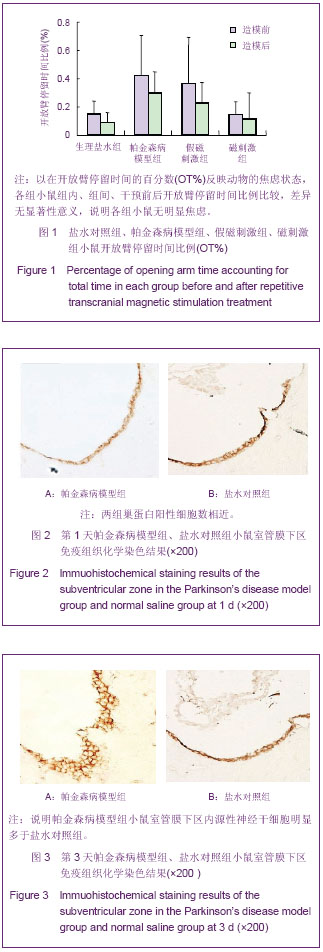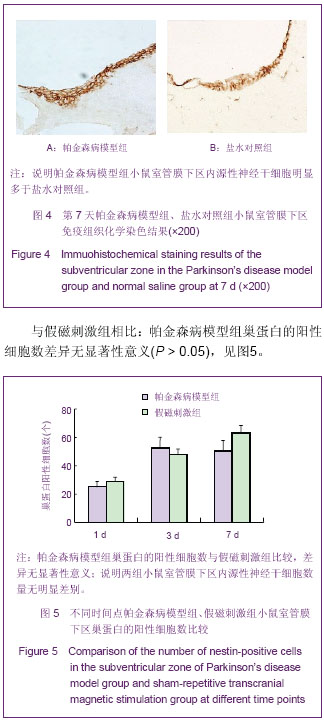| [1] Weintraub D, Comella CL, Horn S. Parkinson's disease-Part 3 Neuropsychiatric symptoms. Am J Manag Care.2008;14(2): S59-69.
[2] 高峻岭,张振建,梅元武,等.经颅磁刺激在帕金森病诊断和治疗中的应用[J].中华物理医学与康复杂志,2004, 26(7):436-437.
[3] Barker AT, Jalinous R, Freeston IL. Non-invasive magnetic stimulation of human motor cortex. Lancet.1985;1: 1106- 1107.
[4] 王全懂,顾平,董巧云,等.重复经颅磁刺激对帕金森病鼠纹状体生长相关蛋白和突触素表达的影响[J]中国老年学杂志, 2008,28 (19):1885-1888.
[5] Vijitruth R, Liu M, Choi DY, et al. Cyclooxygenase-2 mediates microglial activation and secondary dopaminergic cell death in the mouse MPTP model of Parkinson's disease. J Neuroinflammation.2006;3: 6.
[6] Sugama S, Yang L, Cho BP, et al. Age-related microglial activation in 1-methyl 1-4-pheny-1,2,3,6-tetrahydropyridine (MPTP)-induced dopaminergic neurondegeneration in C57BL/6 mice. Brain Research.2003;964(2): 288-294.
[7] Li Y, Chen J, Wang L, et al. Intracerebral transplantation of bone marrow stromal cells in a 1-methyl-4-phenyl-1,2,3, 6-tetrahydropyridine mouse model of Parkinson's disease. Neurosci Lett.2001;316(2): 67-70.
[8] Iwai M, Sato K, Kamada H, et al. Temporal profile of stem cells division, migration, and differentiation from subventricular zone to olfactory bulb after transient forebrain ischemia in gerbils. J Cereb Blood Flow Metob.2003;23 (3): 331-341.
[9] 朱巍.神经干细胞治疗脑缺血性疾病[J].中华物理医学与康复杂志,2002,29(3):1-3.
[10] Wang D, Zhang JJ, Ma JJ, et al. Neural stem cell transplantation with Nogo-66 receptor gene silencing to treat severe traumatic brain injury. Neural Regen Res. 2011;6(10): 725-731.
[11] Zhan Y, Ma DH, Zhang Y. Effects of cotransplantated Schwann cells and neural stem cells in a rat model of Alzheimer’s disease. Neura Regen Res. 2011;6(4): 245-251.
[12] Si LH, Xu TM, Wang FZ, et al. X-box-binding protein 1-modified neural stem cells for treatment of Parkinson’s disease. Neural Regen Res. 2012;7(10): 736-740.
[13] 曾水林,王磊,朱建宝,等.帕金森病大鼠黑质区神经干细胞分化的观察[J].解剖与临床,2007,12(1):27-30.
[14] Rousselet E, Joubert C, Callebert J, et al. Behavioral changes are not directly related to striatal monoamine levels, number of nigral neurons, or dose of parkinsonian toxin MPTP in mice. Neurobiol Dis.2003;14(2): 218-228.
[15] Pascual-Leone A, Valls-Solé J, Brasil-Neto JP, et al. Akinesia in Parkinson’s disease. II. Effects of subthreshold repetitive transcranial motor cortex stimulation. Neurology.1994;44(5): 892-898.
[16] Mally J, Stone TW. Improvement in Parkinsonian symptoms after repetitive transcranial magnetic stimulation. J Neurol Sci. 1999;162(2): 179-184.
[17] Buhmann C, Gorsler A, Bäumer T, et al. Abnormal excitability of premotor-motor connections in de novo Parkinson's disease. Brain.2004; 127(Pt 12): 2732-2746.
[18] Shimamoto H, Takasaki K, Shigemori M, et al. Therapeutic effect and mechanism of repetitive transcranial magnetic stimulation in Parkinson's disease. J Neurol.2001;248 (Suppl 3): 48-52.
[19] Lomarev MP, Kanchana S, Bara-Jimenez W, et al. Placebo-controlled study of rTMS for the treatment of Parkinson's disease. Mov Disord.2006;21(3): 325-331.
[20] Weisstaub NV, Zhou M, Lira A, et al.Cortical 5-HT2A receptor signaling modulates anxiety-like behaviors in mice. Science. 2006;313(5786): 536-540.
[21] Kalueff AV. Neurobiology of memory and anxiety: from genes to behavior .Neural Plast. 2007;18(2): 1-12.
[22] Kent JM, Mathew SJ, Gorman JM. Molecular targets in the treatment of anxiety. Biol Psychiatry.2002;52(10): 1008-1030.
[23] 叶青,李巍,王正荣,等. 不同频率的重复经颅磁刺激的抗抑郁作用[J].西部医学,2007,19(4):516-517.
[24] Weissman J, Trevor A, Chiba K, et al. Metabolism of the nigrostriatal toxin 1-methyl-4-phenyl-1,2,3, 6-tetrahydropyridine by liver homogenate fractions. J Med Chem. 1985;28(8):997-1001.
[25] Sugama S, Yang L, Cho BP, et al. Age-related microglial activation in 1-methyl 1-4-pheny-1,2,3,6-tetrahydropyridine (MPTP)-induced dopaminergic neurondegeneration in C57BL/6 mice. Brain Research.2003;964(2):288-294.
[26] Gould E ,Reeves AJ, Graziano MS, et.al. Neurogenesis in the neocortex of adult primates.Science.1999;286(5439): 548-552.
[27] Svendsen CN, CaldwellMA, Ostenfeld T. Human neural stem cells: isolation, expansion, and transplantation. Brain Patho. 1999;9: 499-513.
[28] Lendahl U, Zimmerman LB, Mckay RD.CNS stem cells express a new class of intermediate filament protein. Cell. 1990;60(4): 585-595.
[29] Hockfield S, McKay RD. Identification of major cell classes in the developing mammalian nervous system. J Neurosci.1985; 5(12): 3310-3328.
[30] 刘惠玲,郎兵,王百忍,等.巢蛋白在成年C57小鼠和SD大鼠中枢神经系统的分布及比较[J].解剖学报,2004,35(2):117-121.
[31] 尹清,刘宏亮,武继祥,等.重复经颅磁刺激对局灶性脑缺血大鼠海马内源性神经干细胞增殖的影响[J].中国微侵袭神经外科杂志, 2009,14(8):368-371.
[32] 刘传玉,梅元武,张小乔,等.经颅磁刺激对脑缺血大鼠功能恢复和健侧突触结构的影响[J].中华物理医学与康复杂志,2005,27 (12): 210-314.
[33] 王全懂,顾平,董巧云,等.重复经颅磁刺激对帕金森病鼠纹状体生长相关蛋白和突触素表达的影响[J].中国老年学杂志,2008, 28(19):1885-1888.
[34] 崔冬生,顾平,刘力,等.低频磁刺激对PC12细胞分化的影响[J]. 中华物理医学与康复杂志,2005,27(12):728-731. |




.jpg)